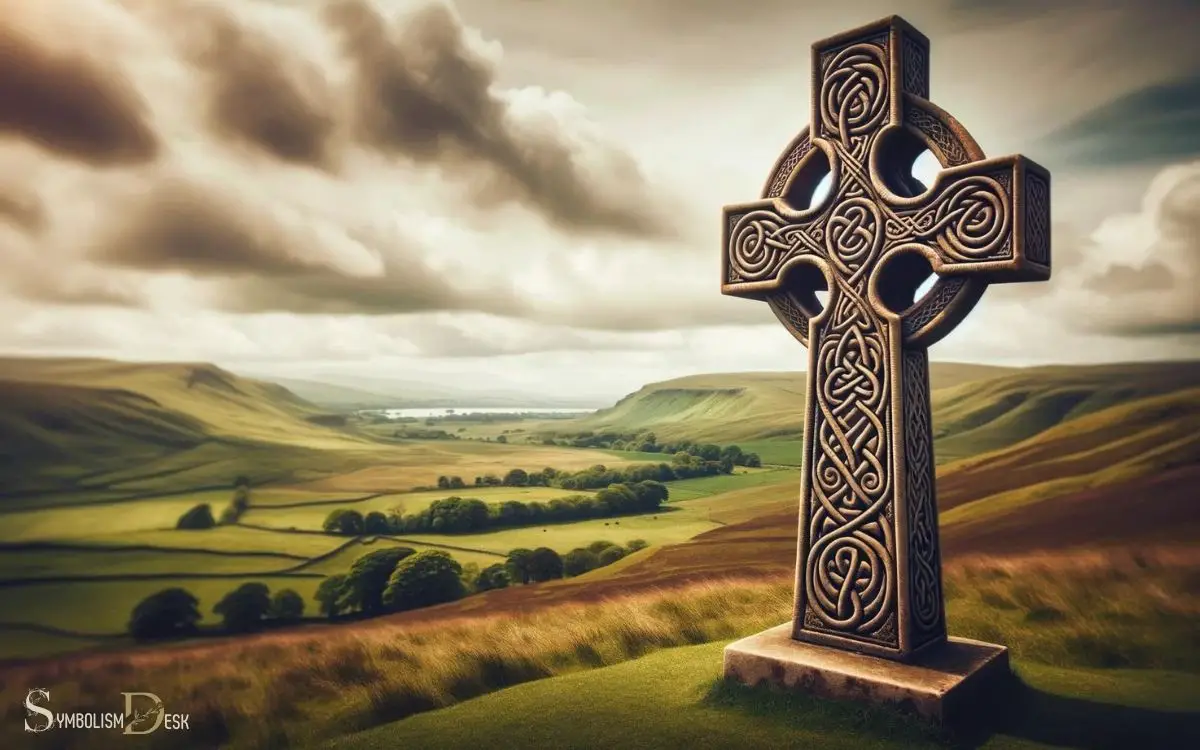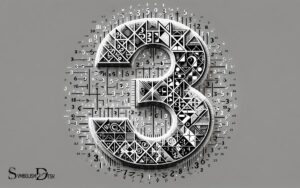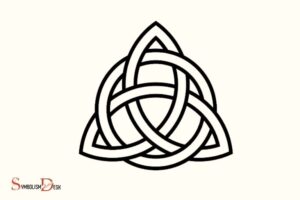What is the Symbolic Meaning of the Celtic Cross? Unity!
The Celtic Cross symbolizes the intertwining of the ancient Celtic faith with Christian beliefs, representing unity, balance, and the journey of life.
Its unique design features a traditional cross accentuated by a circle, which is often interpreted to represent the union of earthly and spiritual realms, and the continuity of life and faith. The Celtic Cross has a rich heritage that can be traced back to early medieval times.
It is characterized by:
- A central cross: symbolizing Christianity and the four directions.
- A surrounding circle: often representing eternity or the sun in pagan beliefs.
- Celtic knot designs: symbolizing the interconnectivity of life and eternity.
Originally, the Celtic Cross may have functioned as a navigational aid or a symbol of the cosmos. Today, it is widely recognized as a symbol of Irish identity and heritage, and it retains religious significance.
Embodying both historical reverence and contemporary significance, the Celtic Cross remains an emblem of cultural identity and spiritual reflection.

Key Takeaway
8 Aspects: Symbolic Meanings of the Celtic Cross
| Aspect | Symbolic Meaning |
|---|---|
| Central Circle | Represents the eternal cycle of life and rebirth |
| Cross | Symbolizes the four elements of earth, air, fire and water |
| Interlaced Patterns | Signifies the connection of life, death and rebirth |
| Positioning | Represents the meeting place of the Divine energies |
| Arms Equal Length | Illustrates the balance between different elements |
| Ring | Stands for the halo of Christ, making it a Christian symbol |
| Knotwork | Depicts continuous movement of life, eternal life |
| Center | Symbolizes the unity and stability of the person’s faith |
Origins of the Celtic Cross
The Celtic Cross originated in early medieval Ireland as a fusion of the Christian cross and the traditional sun wheel symbol.
It’s believed to have been introduced by Saint Patrick, who combined the Christian cross with the circular pattern of the sun wheel, a prominent symbol in Celtic culture.
The circle, representing the sun, was superimposed onto the cross, creating a unique design that blended the old and new faiths.
This fusion symbolized the integration of the Christian beliefs with the Celtic ones, making the transition to Christianity more acceptable to the Celtic people.
The Celtic Cross thus served as a powerful tool for evangelization, carrying deep symbolic meaning and cultural significance. Its origins reflect a pivotal moment in history when two distinct traditions harmoniously coalesced.
Symbolism in Celtic Paganism
The symbolism in Celtic paganism holds deep cultural and spiritual significance. Understanding the origins of the Celtic cross and its ties to ancient Celtic traditions is essential to grasping its symbolic meaning in Celtic paganism.
Celtic Cross Origins
Originating from Celtic paganism, the Celtic cross holds deep symbolism and significance in its design.
The circle at the center of the cross represents the sun, a prominent symbol in Celtic spirituality. This integration of the cross with the circle is believed to symbolize the meeting point of divine energy and the physical world. The design merges the spiritual and the earthly, creating a potent emblem of unity and balance. Much like the symbolic meaning of the barber pole, which intertwines a historical narrative with a deeper significance, the Celtic cross serves as a reminder of the interconnectedness of existence. Both symbols invite reflection on their layered meanings, bridging the past with the present in profound and timeless ways.
The four arms of the cross are often interpreted as representing the four elements – earth, air, fire, and water – or the four directions – north, south, east, and west.
The intricate knotwork often found on Celtic crosses is thought to symbolize the interconnectedness of all life and the eternal nature of the soul.
These origins in Celtic paganism highlight the deeply spiritual and meaningful nature of the Celtic cross.
Spiritual Significance Explained
While commonly associated with Christianity, the Celtic cross holds significant spiritual symbolism in Celtic paganism. In this context, the circle that intersects the cross represents the sun, a prominent deity in Celtic mythology.
The four arms of the cross signify the four elements – earth, air, fire, and water – as well as the four directions, emphasizing the interconnectedness of all things in nature.
The intricate knotwork often found in Celtic crosses symbolizes the eternal cycle of life, death, and rebirth, reflecting the belief in the continuity of existence.
Additionally, the cross is believed to act as a bridge between the physical and spiritual worlds, serving as a potent symbol of protection and spirituality.
Understanding the spiritual significance of the Celtic cross in Celtic paganism provides insight into its enduring appeal and continued relevance in modern times.
Modern Interpretations and Uses
With a growing interest in Celtic spirituality, practitioners today frequently incorporate the symbolic meaning of the Celtic cross in their rituals and ceremonies.
This ancient symbol holds deep significance in Celtic paganism, representing the meeting point of divine energies and the four elements.
In modern interpretations, the Celtic cross is seen as a powerful emblem of balance, unity, and the interconnectedness of all things.
Here is a representation of how the Celtic cross is used in modern Celtic paganism:
| Symbolism | Meaning | Emotional Response |
|---|---|---|
| Circle | Eternity, Wholeness | Sense of Continuity |
| Cross | Union of Opposites | Harmony and Balance |
| Interlacing | Endless Connection | Feeling of Unity |
These interpretations resonate deeply with those seeking a connection to nature and a sense of spiritual harmony.
This modern understanding of the Celtic cross provides a seamless transition into the subsequent section about the ‘evolution of christian adaptation’.
Evolution of Christian Adaptation
The Christian adaptation of the Celtic Cross is a fascinating topic that sheds light on the interplay between different cultures and religious traditions.
The incorporation of pagan roots into Christianity, as exemplified by the Celtic Cross, underscores the cross-cultural influence on religious practices.
Understanding the spiritual significance of the Celtic Cross in Christianity provides valuable insight into the evolution of religious symbolism and beliefs.
Pagan Roots in Christianity
The incorporation of pagan symbolism into Christianity demonstrates the evolution of Christian adaptation. As Christianity spread throughout Europe, it encountered various pagan cultures with their own symbols and beliefs.
In an effort to ease the transition of these cultures into Christianity, many pagan symbols and practices were repurposed or adapted to fit Christian narratives.
This adaptation allowed for a smoother conversion process and facilitated the integration of pagan communities into the Christian fold.
This table below illustrates some of the pagan symbols that were integrated into Christianity and their adapted Christian meanings:
| Pagan Symbol | Adapted Christian Meaning |
|---|---|
| Sun Wheel | Represents the glory of the Risen Son (Jesus) |
| Tree of Life | Symbolizes the eternal life found in Christ |
| Triple Spiral | Adapted to symbolize the Holy Trinity |
Cross-Cultural Religious Influence
How did cross-cultural religious influence shape the evolution of Christian adaptation?
The Celtic Cross, a symbol of both Celtic and Christian heritage, reflects the intricate interweaving of these two cultures.
The adaptation of the cross in Celtic tradition, which predated the arrival of Christianity, illustrates the incorporation of pagan symbols into Christian practices.
This integration enabled early missionaries to bridge the gap between pagan beliefs and Christianity, making the religion more accessible and relatable to the Celtic people.
The circle, a prominent feature of the Celtic Cross, is believed to have represented the sun, an important element in Celtic paganism.
By incorporating this symbol into the cross, it provided a familiar point of connection for the Celts, aiding in the spread and acceptance of Christianity within the Celtic lands.
This cross-cultural religious influence significantly impacted the evolution of Christian symbolism and practices.
This evolution laid the foundation for the spiritual significance of the Celtic Cross in Christianity.
Spiritual Significance in Christianity
Incorporating pagan symbols into Christian practices, the evolution of Christian adaptation seen in the Celtic Cross reflects the spiritual significance of the symbol in Christianity.
The Celtic Cross, with its unique combination of the traditional Christian cross and the circle, holds deep spiritual meaning for Christians.
- The circle represents eternity and the endlessness of God’s love and mercy.
- The intersection of the horizontal and vertical arms symbolizes the union of heaven and earth, reflecting Jesus’ dual nature as both human and divine.
- The intricate knotwork often found on the cross embodies the interconnectedness of all aspects of Christian faith and life.
These elements combined make the Celtic Cross a powerful representation of the spiritual beliefs and values held dear by Christians who embrace its symbolism.
Interpretations Across Celtic Regions
Across Celtic regions, differing interpretations of the symbolic meaning of the Celtic Cross reflect the rich diversity of cultural influences and historical contexts.
- In Ireland, the circle within the cross is often associated with the sun, eternity, or the halo of Christ.
- In Scotland, the Celtic Cross is linked to the ancient Picts and their unique artistic style. In Wales, it may be intertwined with Druidic symbols and beliefs.
- In Cornwall, the cross is seen as a symbol of Celtic identity and heritage, evoking connections to the land and ancestors.
These varying interpretations highlight the complex tapestry of Celtic history and the enduring impact of pre-Christian and Christian traditions on the symbolism of the Celtic Cross.
Understanding these diverse interpretations provides insight into the multifaceted nature of Celtic culture and its enduring symbols.
Elements and Their Symbolic Meanings
The Celtic Cross contains four elements, each with its own symbolic meaning. These elements represent the interconnectedness of the physical and spiritual realms in Celtic belief.
- Earth: The lower portion of the cross signifies the earthly realm, representing stability, grounding, and the importance of staying connected to the land and nature.
- Air: The upper portion of the cross represents the element of air, symbolizing intellect, communication, and the ability to rise above earthly matters to gain a broader perspective.
- Fire: The right arm of the cross embodies the element of fire, signifying passion, transformation, and the spark of inspiration that drives creativity and spiritual growth.
Each of these elements holds significance in Celtic spirituality, weaving together a rich tapestry of symbolism within the Celtic Cross.
Modern Significance and Interpretations
Modern interpretations of the Celtic Cross have gained significance for individuals both within and outside the Celtic tradition.
In contemporary times, the Celtic Cross is often seen as a symbol of unity and integration, representing the coming together of different cultures, traditions, and beliefs.
It’s also viewed as a symbol of hope and resilience, especially in the face of adversity, making it relevant in today’s world.
Additionally, some interpret the intersecting lines of the cross as a representation of the four elements or the four directions, tying it to nature and spirituality.
The enduring popularity of the Celtic Cross in jewelry, tattoos, and artwork reflects its modern significance and the personal meanings individuals derive from it, transcending its historical and cultural origins.
Conclusion
The Celtic cross holds deep symbolic meaning, blending elements of Celtic paganism and Christian adaptation. Its intricate design and rich history make it a powerful symbol of faith, unity, and strength.
From its origins to modern interpretations, the Celtic cross continues to captivate and inspire people around the world. Its significance is as vast as the ocean and as timeless as the stars in the sky.






